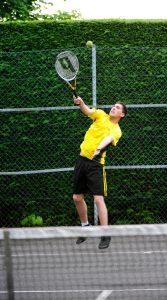We may earn money or products from the companies mentioned in this post.
Introduction

When it comes to tennis practice, having a reliable training tool is essential for players of all levels One such tool that has proven to be incredibly beneficial is a tennis backboard This simple yet effective equipment allows players to engage in independent training sessions, honing their skills and techniques without the need for a practice partner
The Importance of a Tennis Backboard in Practice
Tennis is often regarded as a sport that requires two or more players to fully enjoy and practice However, there are times when finding a practice partner might not be feasible This is where a tennis backboard comes in handy It provides an opportunity for players to engage in solo training sessions, allowing them to work on various aspects of their game independently
By using a tennis backboard, players can focus on specific strokes, footwork, and volleys without the need for someone on the other side of the court This level of independence allows athletes to train at their own pace and experiment with different techniques until they perfect their skills
Advantages of Building Your Own Backboard
If you’re considering incorporating a tennis backboard into your training routine, building your own can offer several advantages over purchasing one from the market
1 Customization:
When you build your own backboard, you have the freedom to customize it according to your specific needs You can choose the size, angle, and material that best suits your playing style and preferences This personalized touch ensures that your training sessions are tailored exactly to what you require
2 Cost-Effective Solution:
Another advantage of building your own backboard is its cost-effectiveness Purchasing a pre-made backboard can be quite expensive, especially if you’re looking for high-quality materials By taking the DIY approach, you can save money and create a backboard that meets your requirements without breaking the bank
Overall, a tennis backboard serves as a valuable training tool for players who wish to improve their game independently Whether you’re unable to find a practice partner or simply want to focus on specific aspects of your technique, a backboard offers the flexibility and customization options needed to enhance your skills Consider building your own backboard and take control of your training sessions today!
Materials and Tools Needed for Building a Tennis Backboard

Backboard Materials Options
When it comes to building a tennis backboard, you have a few material options to consider One popular choice is using wood panels, such as plywood or OSB (Oriented Strand Board). These materials offer versatility and affordability, making them a practical choice for many DIY enthusiasts
On the other hand, concrete walls can also be used for constructing a tennis backboard This involves either pouring concrete or using concrete blocks While this option may require more effort and specialized tools, it offers durability and stability that can withstand intense gameplay
Pros and Cons of Using Wood Material
Using wood panels like plywood or OSB for your tennis backboard comes with its own set of advantages and disadvantages On the plus side, wood is readily available and easy to work with using basic carpentry tools It allows for customization in terms of size and shape, giving you the freedom to design your backboard according to your preferences
However, wood may not fare well against extreme weather conditions unless properly treated or protected It can also wear down over time due to constant impact from tennis balls Regular maintenance in the form of sealing or staining may be required to prolong its lifespan
Pros and Cons of Using Concrete Material
If you opt for concrete walls as the material for your tennis backboard, you’ll benefit from its exceptional durability Concrete can withstand heavy use without significant wear and tear Additionally, it provides excellent rebound properties that mimic real game scenarios
The downside is that constructing a concrete backboard requires more labor-intensive work compared to using wood panels Specialized construction tools like rebar, cement mixers, and trowels are necessary It also lacks the flexibility and customization options that wood offers, as concrete walls are more rigid in shape
Tools Required for Construction
Depending on the type of backboard you choose to build, different tools will be required For wooden backboards, basic carpentry tools like a measuring tape, saw, drill, screws, and other essentials will come in handy These tools allow for precise cutting and secure assembly
On the other hand, if you decide to go with a concrete backboard, construction tools such as rebar (for reinforcement), a cement mixer for proper mixing of concrete, and a trowel for smooth finishing are essential These specialized tools ensure the structural integrity and professional finish of your concrete backboard
Designing the tennis backboard structure

When it comes to designing a tennis backboard, there are several key considerations to keep in mind One of the first aspects to address is the dimensions of the backboard This includes determining the height and width requirements, both in terms of minimum standards and recommended measurements
Height requirements
The height of a tennis backboard is an important factor for players’ practice sessions While there may be no strict rules regarding the minimum height, it’s generally advisable to have a backboard that is at least 10 feet tall This allows players to hit shots comfortably without worrying about their trajectory being compromised by a low-hanging board
Width requirements
Similar to height, there are no specific rules governing the minimum width of a tennis backboard However, it’s recommended that you aim for a width of at least 8 feet This provides ample surface area for players to practice their strokes from various positions on the court
Angle adjustment considerations

The angle at which a tennis backboard is set up can greatly impact the effectiveness of practice sessions It’s crucial to ensure correct angle setup for optimal training outcomes
The importance of correct angle setup
A properly adjusted angle allows players to simulate different shot trajectories and improve their skillset accordingly It also helps create realistic playing conditions, enhancing muscle memory and overall performance on the court
Adjustable angle options
To provide flexibility in practicing different shot types, adjustable angles become essential in a tennis backboard design There are two popular options for achieving this:
-
Hinges and brackets:
Incorporating hinges and brackets into the design allows for easy angle adjustments Players can experiment with various angles, from shallow to steep, to simulate different shots -
Removable supports:
Another option is to have removable supports that allow players to change the backboard’s angle according to their preferences This offers versatility and adaptability during practice sessions
Additional features for enhanced practice experience

To elevate the practice experience further, certain additional features can be incorporated into the design of a tennis backboard
Painting target zones on the board
By painting target zones on the backboard, players can focus their aim and work on precision These zones can act as visual cues, helping players improve their shot placement and accuracy over time
Incorporating ball-return mechanisms
To save time and effort during repetitive drills, integrating ball-return mechanisms into the backboard design is highly advantageous This feature allows players to receive balls after hitting them against the board, enabling continuous practice without constant retrieval interruptions
Step-by-step guide to constructing the tennis backboard

Planning stage: selecting location
Before diving into the construction process, it’s crucial to carefully assess the available space in your home or court Consider the dimensions and shape of the area you have in mind This will help you choose an optimal site for your tennis backboard, taking size restrictions into account
In addition to space considerations, it’s essential to ensure a safe distance from nearby structures or objects You want to avoid any potential accidents or interference while enjoying your game
Construction stage: building the backboard
-
Preparing materials and tools:
Gather all the necessary materials and tools for constructing your tennis backboard This may include wood panels, screws, drills, concrete mix (if applicable), rebar (if using concrete), paint (for optional target zones), and ball-return mechanisms (if desired). -
Setting up the foundation (if necessary):
Depending on your chosen design and location, you might need to create a foundation for stability Ensure that it is level and properly aligned before proceeding with further construction steps -
Assembling/constructing the backboard:
This step varies depending on whether you are building a wooden or concrete backboard-
If constructing a wooden backboard:
Cut the wood panels according to your desired size and shape Drill holes where needed for screws, then proceed to screw the panels together securely -
If building a concrete backboard:
Mix concrete according to instructions, ensuring proper consistency Pour or stack blocks as per your chosen design while reinforcing with rebar for added strength
-
-
Securing the backboard to its support structure:
Once your backboard is constructed, it’s time to secure it in place-
If you have an existing wall or fence:
Use appropriate anchoring techniques to attach the backboard securely Ensure it is level and stable -
If creating a standalone support frame:
Build a sturdy frame that can hold the weight of the backboard Anchor it firmly to the ground for stability
-
Finishing touches
Now that your tennis backboard is securely in place, you can add some finishing touches to enhance your playing experience
-
Painting target zones on the board (optional):
To improve accuracy and challenge yourself, consider painting target zones on your backboard These zones will help you practice different shots and improve your skills over time -
Adding ball-return mechanisms (optional):
If you want to save time retrieving balls during practice sessions, consider installing ball-return mechanisms These handy devices will bring the balls back to you swiftly, allowing for uninterrupted training sessions
By following this step-by-step guide, you’ll be able to construct a tennis backboard that meets your space requirements while providing a solid surface for perfecting your shots Get ready to enjoy countless hours of practice and improvement!
Useful Links

Tennis Court Equipment and Tennis Backboard Hitting Walls
Diy Tennis Backboard – Mary Catherine blog
Tennis Wall Practice
Tennis backboards/ hitting walls Supplies
Bakko Economy Flat Series Backboard – Active Sports
How do you make a portable tennis backboard?
Tennis wall setup in my garage. : r/10s
Tennis Practice Backboards
Tennis Backboards
Tennis Backboard for Excellent Rebound and Low Noise
Sound damping for tennis backboard
Tennis practise walls made of polymer concrete
Tennis Practice Walls – Dallas
REBO walls – Leading the global movement in wall practice …
Rally Master Tennis Backboards
Backboard Comparison
Reasons to Use a Tennis Backboard






